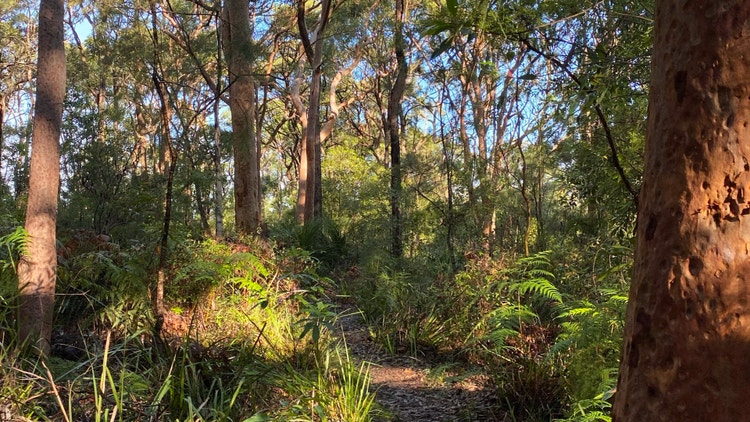

Program
This excursion provides a case study of the long-nosed bandicoot and its habitat. Students will collect data on abiotic and biotic factors and human activities. The data will be analysed to assess habitat suitability and evaluate management strategies. This program emphasises scientific inquiry and can support a Depth Study.
Inquiry questions
- How do biotic and abiotic factors affect animal populations in natural areas?
- What fieldwork and analysis methodologies are needed for a valid and reliable habitat survey?
- How can human activities impact natural ecosystems and how should they be managed?
Fieldwork
Abiotic and biotic sampling
Students will conduct an ecological survey of two bushland sites to assess their suitability as habitats for the long-nosed bandicoot. They will use various fieldwork instruments and sampling methods to collect quantitative and qualitative data on biotic and abiotic factors relevant to the bandicoot’s ecological niche. They’ll record their data and observations using worksheets and digital technologies.
Human activities, impacts and management survey
Students find and record evidence of human activities at this site, identify environmental impacts, and develop management strategies to ensure the survival of the threatened long-nosed bandicoots.
Data interpretation, processing and analysis
Digital spreadsheets and graphic organisers will help students identify and discuss patterns and trends in their data. Staff will guide students to draw preliminary conclusions about their fieldwork inquiry questions.
Location options

Buffalo Creek Reserve
Main location - including risk assessment and risk management advice, bus map and track overview.

Field of Mars Reserve
Additional location - including risk assessment and risk management advice, bus map and track overview.
Essential information
| Cost 2025 |
DoE school $26 per student – GST free Non-gov school $36 per student – GST free, minimum charge $750 |
| Cost 2026 |
DoE school $27 per student – GST free Non-gov school $37 per student – GST free, minimum charge $750 per class |
| Classes | Maximum 6 classes per day - maximum 3 classes per location. |
| Bring |
View Preparing for your excursion. Bring worksheet, writing equipment, clipboard, medications, low-waste food, water bottles, sunblock, hat and raincoat in a backpack. Sports uniform recommended. This program requires students to use a mobile device to record data. Inform the centre if devices are not permitted. |
| Welfare |
Rugged bushwalking, not wheelchair accessible. May not suit recently unwell participants. For medical or special needs notify staff prior to program. |
| Extreme or wet weather | Program may be modified, postponed or cancelled due to predicted extreme temperatures, bush fire danger, heavy rainfall, high winds or dust storms. |
| Booking policy | Confirm student numbers and classes 7 days in advance. |
| Cancellation fee |
Less than 30 working school days – $600 Less than 7 working school days notice – full cost Weather or fire danger cancellation – $0 |
| Worksheet |
Schools are responsible for printing student worksheets. |
| Teacher resources | Teacher programming folder |
| Supporting resources | |
| Pre-visit learning |
Pre-fieldwork student activities Fieldwork techniques YouTube playlist |
| Time | Activities |
| 9.30 - 10.00 |
Introduction and fieldwork preparation Food break and toilets |
| 10.00 - 10.50 | Fieldwork activity 1 |
| 10.50 - 11.20 | Food break |
| 11.20 - 12.10 | Fieldwork activity 2 |
| 12.10 - 12.40 | Food break and toilets |
| 12.40 - 1.30 | Fieldwork activity 3 |
| 1.30 - 2.00 | Data processing and conclusions |
| 2.00 - 2.15 | Pack up and depart |
Biology Stage 6 Syllabus (2017)
Outcomes
A student:
- develops and evaluates questions and hypotheses for scientific investigation BIO11/12-1
- designs and evaluates investigations in order to obtain primary and secondary data and information BIO11/12-2
- conducts investigations to collect valid and reliable primary and secondary data and information BIO11/12-3
- selects and processes appropriate qualitative and quantitative data and information using a range of appropriate media BIO11/12-4
- analyses and evaluates primary and secondary data and information BIO11/12-5
- analyses ecosystem dynamics and the interrelationships of organisms within the ecosystem BIO11-11
Module 4 Ecosystem Dynamics
Content
Students investigate and determine relationships between biotic and abiotic factors in an ecosystem, including:
- the impact of abiotic factors
- the impact of biotic factors, including predation, competition and symbiotic relationships
- the ecological niches occupied by species
- predicting consequences for populations in ecosystems due to predation, competition, symbiosis and disease
- measuring populations of organisms using sampling techniques
Students analyse evidence that present-day organisms have evolved from organisms in the past by examining and interpreting a range of secondary sources to evaluate processes, claims and conclusions relating to the evolution of organisms in Australia, for example:
- small mammals
Students investigate changes in past ecosystems that may inform our approach to the management of future ecosystems, including:
- the role of human-induced selection pressures on the extinction of species
- models that humans can use to predict future impacts on biodiversity
- the role of changing climate on ecosystems
Students investigate practices used to restore damaged ecosystems, country or place, for example:
- mining sites
- land degradation
Biology Stage 6 Syllabus © NSW Education Standards Authority (NESA) for and on behalf of the Crown in right of the State of New South Wales, 2017



